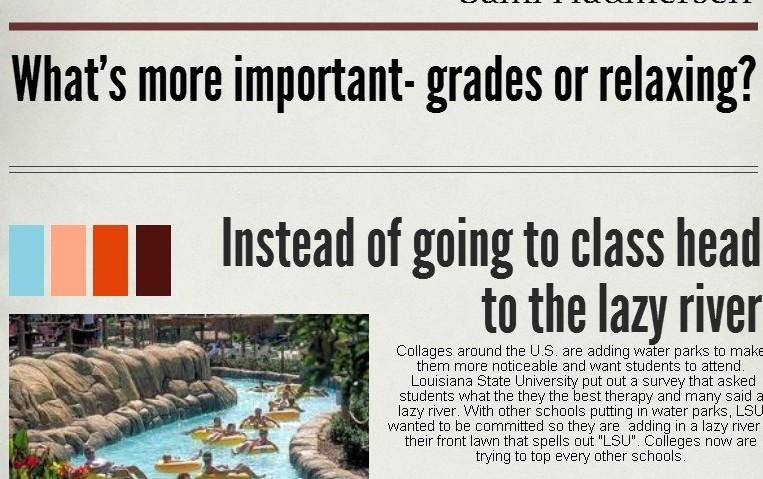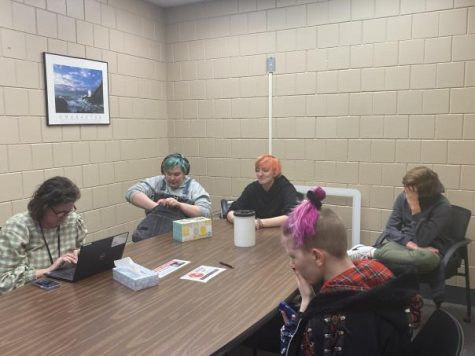Colleges make the switch from education to vacation
In discussion of renovations to make university campus’ more visually and socially appealing to incoming students, colleges have shifted their attention on academic purposes and increased construction of campus amenities, such as water parks and lazy rivers. This has become a popular trend of competition for enrollment based on student amenities. However, it mostly attends to the needs of the least academically motivational students and encourages more of them to apply. College water parks are unnecessary, expensive luxuries that will increase tuition costs whether students use them or not and do not benefit the student’s academic achievements.
Since 2012, 92 colleges have invested in 157 campus projects with a total cost of $1.7 billion according to Simon Bravo, spokesman for NIRSA: Leaders in Collegiate Recreation. The most expensive part of a recreational center to operate is pools. It makes sense why colleges are attempting to lure students to their campus so they can pay for it themselves. As colleges increase tuition to pay for unnecessary luxuries, it turns them into more of a business than a school.
As more water parks appear, it is becoming clear that colleges are trying to make more money rather than make more smart students. In a 2013 analysis by the Natural Bureau of Economic Research, very few students value academic education over campus amenities. Thirty-six percent of students spend five hours a week studying. It is a bad reflection on the school to take away time to study and leave them unprepared for the real world.
“When you think about our sedentary lifestyle today, if you can get some kid out on a zip line instead of playing video games and eating pizza, that’s a huge win,” said David Greusel of Convergence Design at the University of Toledo. “It’s also the logic of the grocery store: Once you get them in the door, they’re going to buy something else. Once you get them in the rec center for the pool, maybe they’re going to sign up for a yoga class.”
Some institution’s renovations for water facilities include Louisiana State in construction till of a pool and lazy river in the shape of their ‘LSU’ brand font. Texas Tech spent over $8.4 million on a lazy river, tanning deck and water slide. At Missouri State, students can attend a ‘dive-in’ movie on a projector screen overlooking the large pool and hot tub area. North Dakota State will start construction next fall for a zip line that students can ride over the water, a 36 feet vortex of swirling water slide, a rain-misting garden and a fireplace on an island in the middle of the pool that students can swim up to. Clemson University in South Carolina added ‘blobs’, or floating foam matresses, for students to jump on like an obstacle course. University of Michigan has an indoor beach club, palm trees, lazy river and waterfall modeled after the aquatic area of the Playboy Mansion.
A common company in the construction of college’s water parks is AquaClimb Sports. Overall, they have placed 10 climbing walls on college campus’ with 35 in the works. Founded in 2002, AquaClimb “help pools capitalize on the sport’s soaring popularity by giving people a highly enjoyable, yet totally safe way to climb in the water,” according to AquaClimb Sport’s website. Pensacola Christian College in Florida spent over $1 million on a wave rider made by AquaClimb.
In an on campus poll, 74 percent of Auburn University students voted to raise their activity costs $7.50 to $200 to fund the $52.5 million upgrades to the recreation facilities and to build a 45 person paw-print hot tub and a 20 ft climbing wall mounted alongside the pool.
These resort style amenities have increased enrollment at less-elite schools and stir up fear that a higher education institution will turn into a four-year vacation rather than four years of education. According to data from the Labor Department, the price index for college tuition grew by nearly 80 percent between August 2003 and August 2013. As student’s wants and needs for entertainment increase, so will the tuition. This is a concerning factor for the future of college education and if it will even be considered education at all.

Lucy Langmack is a senior print Editor-in-Cheif. She has been involved with newspaper since her junior year and loves every minute of it! She has been...








Megan McGuire • Nov 8, 2014 at 7:35 pm
The headline of this article was very creative and attention grabbing, drawing me into wanting to read the whole thing. The article itself was just as intriguing and interesting, with a variety of examples and facts supporting the opinion. I was not only entertained by this article, but also informed with the example and supporting quotes from specific colleges. This article makes you think and wonder who comes up with these additions to college campuses that make them seem more like a vacation than school and learning. Overall, very entertaining and engaging article.
emily ness • Oct 27, 2014 at 3:36 pm
I really like the title of your article – very creative! I thought that your introduction was solid. You included a lot of valuable information. Good job embedding quotes!